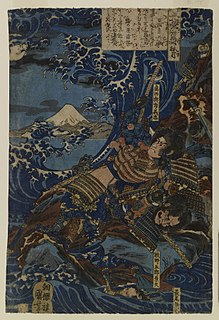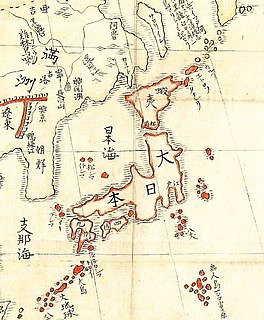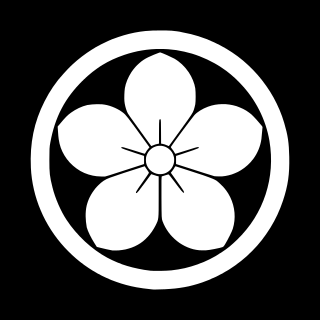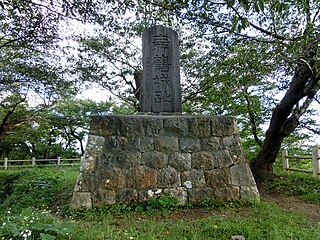Related Research Articles

Edo, also romanized as Jedo, Yedo or Yeddo, is the former name of Tokyo.

Minamoto no Yoritomo was the founder and the first shogun of the Kamakura shogunate of Japan, ruling from 1192 until 1199. He was the husband of Hōjō Masako who acted as regent (shikken) after his death.

Minamoto no Yoshinaka, Kiso no Yoshinaka, or Lord Kiso was a general from the late Heian period of Japanese history. A member of the Minamoto clan, Minamoto no Yoritomo was his cousin and rival during the Genpei War between the Minamoto and the Taira clans. Yoshinaka was born in Musashi province. His dharma name was Tokuon'in Gisan Senkō (徳音院義山宣公).

Hōjō Masako was a political leader who exercised significant power in the early years of the Kamakura period, which was reflected by her contemporary sobriquet of the "nun shogun". She was the eldest daughter of Hōjō Tokimasa and sister of Hōjō Yoshitoki, both of them shikkens of the Kamakura shogunate. She was the wife of Minamoto no Yoritomo, and mother of Minamoto no Yoriie and Minamoto no Sanetomo, the first, second and third shōguns of the Kamakura period.

Ōta Dōkan, also known as Ōta Sukenaga or Ōta Dōkan Sukenaga, was a Japanese samurai warrior-poet, military tactician and Buddhist monk. Ōta Sukenaga took the tonsure as a Buddhist priest in 1478, and he also adopted the Buddhist name, Dōkan, by which he is known today. Dōkan is best known as the architect and builder of Edo Castle in what is today modern Tokyo; and he is considered the founder of the castle town which grew up around that Ōnin era fortress.

Sagami Province was a province of Japan located in what is today the central and western Kanagawa Prefecture. Sagami bordered on Izu, Musashi, Suruga Provinces; and had access to the Pacific Ocean through Sagami Bay. However, most of the present-day cities of Yokohama and Kawasaki, now part of Kanagawa Prefecture, were not in Sagami, but rather, in Musashi Province. Its abbreviated form name was Sōshū (相州).

The Battle of Ishibashiyama was the first in which Minamoto no Yoritomo, who became shōgun less than a decade later, was commander of the Minamoto forces. The battle was fought on September 14, 1180, in the southwest of present-day Odawara, Kanagawa Prefecture, near Yoritomo's headquarters at Kamakura.

The Tokugawa clan is a Japanese dynasty that was formerly a powerful daimyō family. They nominally descended from Emperor Seiwa (850–880) and were a branch of the Minamoto clan through the Matsudaira clan. The early history of this clan remains a mystery. Members of the clan ruled Japan as shōguns from 1603 to 1867.

The Takeda Clan was a Japanese clan active from the late Heian period until the late 16th century. The clan was historically based in Kai Province in present-day Yamanashi Prefecture. The clan reached its greatest influence under the rule of Takeda Shingen, one of the most famous rulers of the period.

This is the glossary of Japanese history including the major terms, titles and events the casual reader might find useful in understanding articles on the subject.

The Date clan is a Japanese samurai kin group.

The Satake clan was a Japanese samurai clan that claimed descent from the Minamoto clan. Its first power base was in Hitachi Province. The clan was subdued by Minamoto no Yoritomo in the late 12th century, but later entered Yoritomo's service as vassals. In the Muromachi period, the Satake served as provincial deputy (shugo) of Hitachi Province, under the aegis of the Ashikaga shogunate. The clan sided with the Western Army during the Battle of Sekigahara, and was punished by Tokugawa Ieyasu, who moved it to a smaller territory in northern Dewa Province at the start of the Edo period. The Satake survived as lords (daimyō) of the Kubota Domain. Over the course of the Edo period, two major branches of the Satake clan were established, one ruled the fief of Iwasaki, the other one the fief of Kubota-Shinden.

Aizu Domain was a domain of the Tokugawa Shogunate of Japan during the Edo period from 1601 to 1871.
Matsuda clan is a Japanese family tracing its origins to Bizen Province, and heirs of Fujiwara no Hidesato.

The Ōta clan was samurai kin group which rose to prominence in Sengoku and Edo period Japan. Under the Tokugawa shogunate, the Ōta were hereditary vassals of the Tokugawa clan.
Edo Shigenaga was the second head of the Edo clan. He first settled and lent his name to the fishing village Edo that eventually grew to become Tokyo. He was also known as Edo Taro.

Murakami Castle is a Japanese castle located in Murakami, northern Niigata Prefecture, Japan. At the end of the Edo period, Murakami Castle was home to a cadet branch of the Naitō clan, daimyō of Murakami Domain under the Tokugawa shogunate. The castle was also known as "Maizuru-jō" (舞鶴城). The ruin been protected as a National Historic Site since 1993. It is about 30 minutes on foot from Murakami Station on the JR East Uetsu Line.

Sugaya Yakata (菅谷館) was a Japanese castle located in what is now the town of Ranzan, Hiki District, Saitama, Japan. Its ruins have been protected as a National Historic Site, since 2008.

Tozawa clan was a Japanese samurai kin group from Mutsu and Dewa Provinces who ruled as daimyō of Shinjō Domain under the Edo period Tokugawa shogunate. The Tozawa clan residence in Edo was located near the temple of Zōjō-ji.